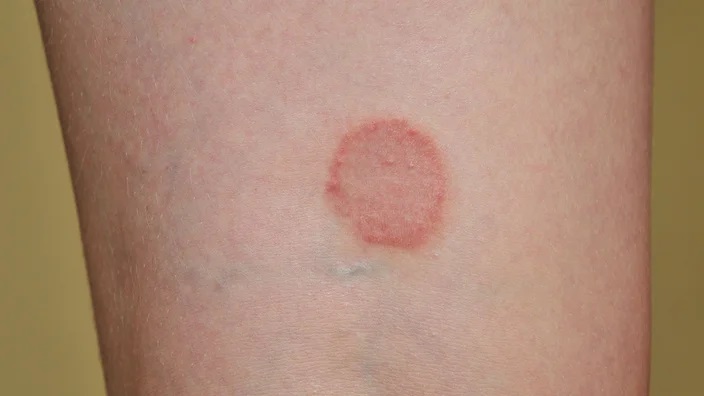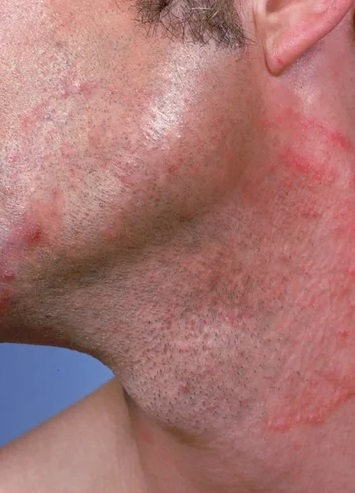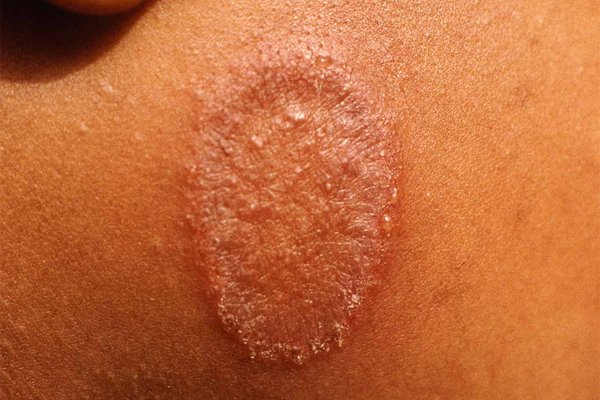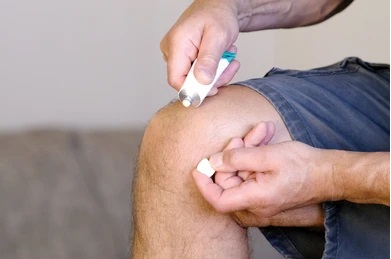What Is a Fungal Infection / Ringworm?

Causes and Transmission
Dermatophyte fungi thrive in warm, moist environments. Infection can occur when fungal elements contact susceptible skin. Transmission pathways include:
- Direct skin‑to‑skin contact with an infected person.
- Contact with infected animals (pets, livestock).
- Contaminated objects (fomites): towels, clothing, hairbrushes, sports gear, wrestling mats, gym equipment.
- Shared or damp environments: locker rooms, public showers, swimming pools.
- Occlusive or tight clothing and prolonged sweating (athletes, outdoor workers).
- Inadequate drying of skin folds, feet, or groin after bathing or exercise.
Symptoms
General symptoms of superficial fungal infection of skin include:
- Round (ring-shaped) rash, with active scaly border.
- Itching, burning, or irritation.
- Redness, scaling, cracking, or flaking skin.
- Central clearing or variable pigmentation changes..
By Anatomic Site,
- Tinea corporis (body ringworm): Ring-shaped rash on trunk, limbs, or face; often what patients mean by “ringworm rash.”
- Tinea pedis (athlete’s foot): Scaling, maceration, or fissures between toes; may extend to soles of feet
- Tinea cruris (jock itch): Itchy, sharply marginated red rash in groin, inner thighs, or buttock folds; more common in humid climates and in people who wear tight clothes.
- Tinea capitis (scalp ringworm): Scaly patches, broken hairs, or areas of hair loss; may produce black dots or diffuse scaling, especially in children.
- Tinea unguium / Onychomycosis (nail fungus): Thickened, brittle, yellow or discolored nails; subungual debris; may coexist with tinea pedis.

Prevention: Reducing Risk of Fungal Skin Infection
Preventive steps are central to controlling recurrence and community spread.
- Practice good hygiene: wash daily; dry skin folds, feet, and groin thoroughly.
- Change socks, underwear, and workout clothes after sweating.
- Wear breathable, moisture-wicking fabrics; avoid prolonged use of tight gear.
- Do not share personal items (towels, combs, athletic pads, helmets, razors, nail clippers).
- Consider prophylactic use of antifungal powder or spray (especially for recurrent athlete’s foot).
- Launder towels, bedding, and athletic uniforms in hot water; dry completely.
- Maintain overall health—balanced diet, stress management, adequate sleep—to support immune function.
Emerging Pathogen: Trichophyton indotineae
Trichophyton indotineae is an emerging dermatophyte species associated with widespread, chronic, and treatment-refractory tinea corporis and tinea cruris in many regions, including parts of costal Karnataka and beyond. Of clinical concern, isolates have shown reduced susceptibility and, in some reports, resistance to terbinafine.
Management may require systemic antifungal therapy and longer treatment durations. Because resistance patterns evolve, doctors consider mycologic testing (culture, molecular identification, susceptibility) in persistent or recurrent cases.

Diagnosis
Accurate diagnosis guides appropriate antifungal therapy and reduces unnecessary antufungal use.
Typical diagnostic steps:
- Clinical evaluation: at a qualified dermatologist
- Potassium hydroxide (KOH) microscopy of skin scrapings, nail clippings, or plucked hairs to detect fungal hyphae or spores.
- Fungal culture to identify species—important in recalcitrant, widespread, or atypical infections.
- Dermoscopy or Wood’s lamp in selected cases (some Microsporum species fluoresce).
- Molecular or sequencing methods (where available) to detect species such as T. indotineae or to assess antifungal resistance.
Treatment Options
Therapy is guided by infection site, severity, extent, patient factors, and potential drug interactions.
Topical Antifungal Agents (First-Line for Limited Skin Disease)
Common options include:
- Allylamines: terbinafine, naftifine.
- Azoles: clotrimazole, miconazole, ketoconazole, econazole.
- Others: ciclopirox, tolnaftate.
General use principles:
- Apply once or twice daily (agent specific) to the lesion and 2 cm beyond the margin.
- Continue for the full recommended duration (often 1–4 weeks) and at least 1 week beyond visible clearing, per product instructions.
- Topical powders or sprays may help keep high-moisture areas dry (feet, groin).
Oral (Systemic) Antifungals
Indications: Extensive skin involvement; tinea capitis; onychomycosis; infections unresponsive to topical therapy; suspected resistant dermatophyte (e.g., T. indotineae); immunocompromised host. These should be taken only with a dermatologist’s prescription.
Common systemic agents:
- Terbinafine (note emerging resistance in some dermatophyte species; still widely used, particularly for nail fungus).
- Itraconazole (pulse or continuous regimens; often used when terbinafine resistance suspected).
- Fluconazole (selected regimens; variable efficacy by species/site).
- Griseofulvin (historically used for tinea capitis; still preferred in some pediatric scenarios depending on organism).
Systemic therapy requires medical supervision for dosing and duration

Adjunctive Measures During Treatment
- Keep the affected area clean and dry.
- Remove or disinfect contaminating items (combs, hats, sports gear).
- Treat household contacts or pets if indicated (veterinary evaluation for animals).
- Address predisposing factors: occlusive clothing, hyperhidrosis, maceration of skin.
Self-Care and Home Management
Patients undergoing treatment for ringworm or other fungal skin infections should:
- Clean the affected area gently with soap and water; dry completely before applying medication.
- Use topical antifungal cream, ointment, gel, or spray exactly as directed.
- Avoid scratching to limit spread; keep nails short.
- Wear loose, dry, breathable clothing around affected sites.
- Change socks and innerwear daily (more often if sweating heavily).
- Wash clothing, towels, and bedding in hot water; dry on high heat.
Frequently Asked Questions (FAQs)
Is ringworm contagious?
Yes. It can spread between people, from animals to people, and via contaminated objects or surfaces. Prompt diagnosis and treatment reduce transmission.
How do I know if I have ringworm versus eczema or psoriasis?
Ringworm (tinea corporis) often forms an enlarging ring with a more active scaly edge and clearer center. Eczema and psoriasis typically lack this advancing ring border and may appear in different distribution patterns. A doctor can examine and, if needed, perform a KOH test to confirm.
Can ringworm go away without treatment?
Some mild cases may eventually resolve, but untreated infection can persist, enlarge, and spread to others. Treatment shortens illness and lowers transmission risk.
Are home remedies effective?
There is no scientific evidence supporting the efficacy of commonly used home remedies. Use them only as adjuncts, not replacements. Seek medical advice for persistent rash as soon as possible.
When should I see a doctor?
Seek medical attention promptly. Delayed treatment can cause the infection to spread and may result in the need for oral antifungals and prolonged therapy.
Yes. It can spread between people, from animals to people, and via contaminated objects or surfaces. Prompt diagnosis and treatment reduce transmission.
Ringworm (tinea corporis) often forms an enlarging ring with a more active scaly edge and clearer center. Eczema and psoriasis typically lack this advancing ring border and may appear in different distribution patterns. A doctor can examine and, if needed, perform a KOH test to confirm.
Some mild cases may eventually resolve, but untreated infection can persist, enlarge, and spread to others. Treatment shortens illness and lowers transmission risk.
There is no scientific evidence supporting the efficacy of commonly used home remedies. Use them only as adjuncts, not replacements. Seek medical advice for persistent rash as soon as possible.
Seek medical attention promptly. Delayed treatment can cause the infection to spread and may result in the need for oral antifungals and prolonged therapy.
Key Takeaways
- Fungal skin infections (ringworm, tinea) are common, contagious, and treatable.
- Presentation varies by body site—recognize athlete’s foot, jock itch, scalp ringworm, and nail fungus as related conditions.
- Good hygiene, moisture control, and avoidance of shared personal items reduce risk and recurrence.
- Topical antifungal therapy is effective for most limited skin disease; systemic antifungals are needed for extensive, scalp, nail, or resistant infections.
- Trichophyton indotineae is an emerging concern with possible terbinafine resistance; consider medical evaluation for persistent or widespread rash.
This blog article is for educational purposes and does not replace professional medical advice. Patients should consult a qualified healthcare provider for diagnosis and treatment tailored to their individual needs.
